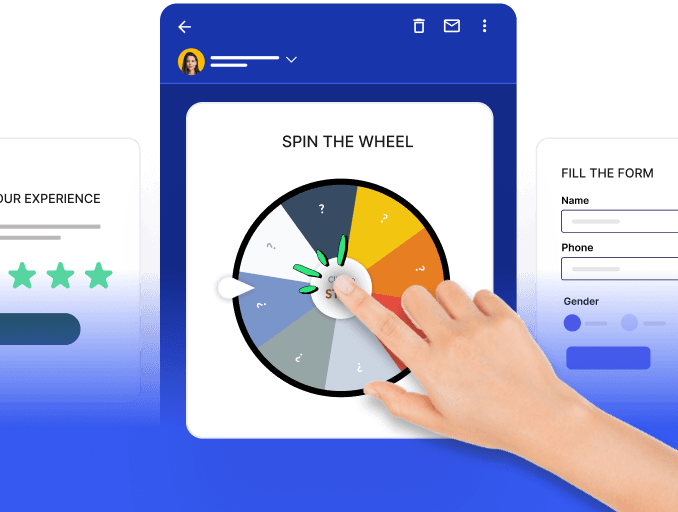Email marketing remains the primary marketing channel for businesses. But email marketers face the biggest challenge in getting their emails into inboxes.
What happens to those emails that don’t make it to the inbox? That’s where the return path email enters. It provides you with the reason backed by data behind the bounces.
This guide is a deep dive into return path email and lets you know about it.
Let’s jump right in.
Table of contents
- What is a return path email?
- How does the return path work?
- Importance of return path in email marketing
- How to create a custom return path?
- Variable envelope return path(VERP)
- Takeaways
What is a return path email?
The return path email is an email header communicating with SMTP servers regarding where bounced emails should be sent, basically the Non-delivery report.
This keeps you - the sender, in the loop with undelivered emails as the return path fetches the reason behind delivery errors. During the SMTP session, the recipient's email server generates the return path, which captures the original data from the sender's information.
Let’s understand how the return path works.
How does the return path work?
Let’s say you send your email campaign of 100 messages. The first part of the email journey is having the recipient’s Mailbox providers receive the message, ensuring complete delivery. While the second half of the email journey begins here and ends with getting your emails delivered to your inbox.
There’s a possibility that not all your emails will be delivered to your inbox. What happens to these emails? The emails would have bounced. Bounces are of two types: Soft and hard bounces.
💡Related guide: All About Hard Bounce & Soft Bounce
What happens after the bounce? Where do they go?
Your inbox might be flooded with non-delivery messages, or you may need to realize why they bounce. Either way, it's detrimental to the sender's reputation.
That’s why we need to know the working of the return path email header. The return path header is not inserted at the beginning of the SMTP session. According to RFC 5321, the recipient’s mailbox inserts the return path after accepting it.
There should exist only one return path, and as and when they result in a bounce, the mail servers will send email notifications to the return path’s address. Undeliverable messages may be notified in separate emails or as one email.
Importance of return path in email marketing
Dealing with bounces is a headache, and the number of undelivered messages just adds to the clutter of your inbox without a return path.
Using a return path header also helps in the DMARC authentication process of emails. Failing this authentication check exposes emails to phishing attacks.
To pass the DMARC authentication, emails must pass the alignment tests posed by SPF and DKIM. Because without this, emails get rejected, thus damaging your email deliverability and the sender’s score.
In addition to this, your inbox is clutter-free as you can carry on with your work and attend to bounce errors whenever you want.
How to create a custom return path?
Some email service providers like Mailmodo let you create your custom return path. This includes setting up a custom return path domain within the platform and verifying it with the DNS record.
The steps vary with every email service provider's policy and configurations regarding domain setup. Look into the ESP’s documentation to check for step-by-step instructions.
With a custom return path domain, the SPF alignment is achieved easily. Since Sender Policy Framework is a path-based authentication system that protects domains from spoofing by allowing senders to specify which email servers are permitted to send messages on behalf of the domain. It matches the sender's IP address with the approved IP address. If you get through, your emails reach the inbox, or be prepared to land in spam.
Variable envelope return path(VERP)
Variable Envelope Return Path (VERP) is a technique used in email systems to detect and remove undeliverable email addresses automatically. Each recipient uses a different return path or envelope sender address. It is especially useful for managing bounced emails and improving delivery rates.
It helps streamline the process of identifying undeliverable addresses and managing bounce notifications. Email senders can more effectively manage bounce messages by having separate return paths for each recipient, which helps maintain clean recipient lists and improve deliverability.
Takeaways
The return path email is akin to perfecting a dance move - implementing it helps analyze and ensure the reason behind the bounce and helps tailor your efforts to have your message land exactly in the inbox. In addition to providing a place for bounced emails, return path email also holds raw data that made them occur in the first place, which is a crucial component of email delivery and deliverability.
What you should do next
Hey there, thanks for reading till the end. Here are 3 ways we can help you grow your business:
Talk to an email expert. Need someone to take your email marketing to the next level? Mailmodo’s experts are here for you. Schedule a 30-minute email consultation. Don’t worry, it’s on the house. Book a meet here.
Send emails that bring higher conversions. Mailmodo is an ESP that helps you to create and send app-like interactive emails with forms, carts, calendars, games, and other widgets for higher conversions. Get started for free.
Check out our AI prompts library. If you need AI prompts for ChatGPT or Bing, here's a ready-made database we’ve built to help marketers succeed at prompt engineering. Get your AI prompts here.
Get smarter with our email resources. Explore all our knowledge base here and learn about email marketing, marketing strategies, best practices, growth hacks, case studies, templates, and more. Access guides here.







